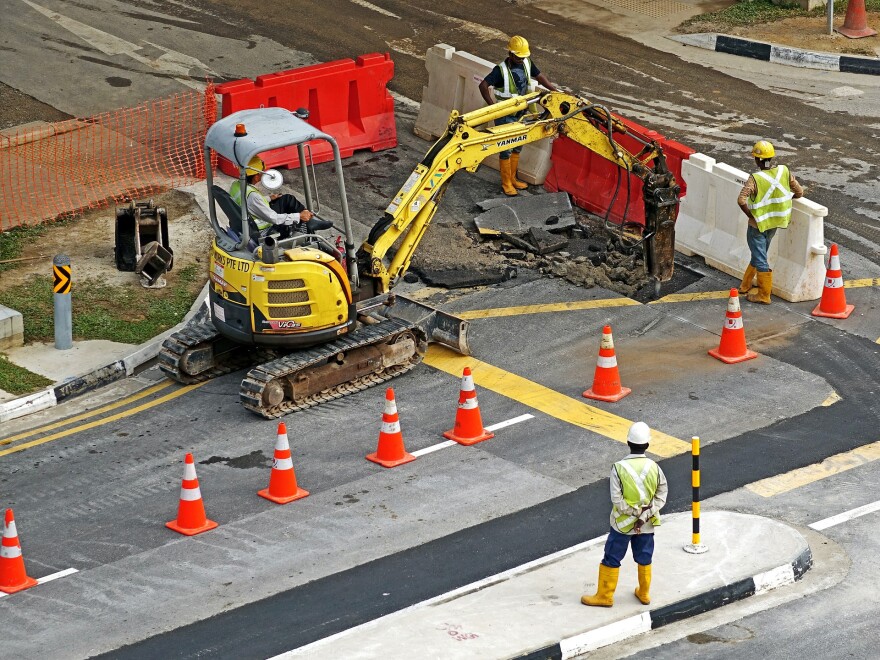All kinds of signs can decorate a highway work zone. One local lawmaker wants to make sure at least one enforcing speed is taken more seriously.
Joseph LaQuatra, business manager of the Laborers’ Local No. 1058, which represents Pittsburgh highway workers, said signs for speed cameras make a difference.
“All you see is break lights,” LaQuatra said, referring to drivers slowing down after spotting speed cameras in the 13 states where they're required. “People actually go the speed limit through the work zone. Up here (in Pennsylvania) … there’s no consequence.”
According to PennDOT officials, Pennsylvania saw 2,000 work zone crashes with 23 deaths in 2015.
Democratic state Sen. Judy Schwank of Berks County is co-sponsoring a bill that would place cameras in construction zones on interstate highways and the Pennsylvania Turnpike.
The Senate could vote as early as Thursday, and Schwank said she isn’t interested in producing revenue by promoting technology use on the road.
As written, the legislation would establish a five-year pilot period in which any driver going 11 miles per hour over the posted speed limit will receive a $100 fine with no points added to his or her record.
Initially proposed in the Senate in June 2015, the bill was later referred to the transportation committee, whose members proposed 90 percent of its funding should fuel the Pennsylvania State Police to pay for training and equipping patrols in mobile and short-term highway work zones.
Schwank said that amendment has become a point of contention and was stripped from the bill. It’s likely the measure could be proposed again, she said, stalling it further.
A 2012 report found that state police raked in $5.7 million in overtime for work zone coverage. According to Schwank's office, Pennsylvania currently pays between $6 and $7.5 million in overtime to state police. In addition, police can’t always physically station themselves within work zones, making it difficult to monitor cars rear-ending one another or hitting fixed objects.
Schwank's office estimates that Pennsylvania could rake in nearly $21 million in new revenue, based on a similar program already in place in Maryland. In the first 30 months of the program, Maryland saw more than 800,000 violations, resulting in roughly $33 million before accounting for operating costs of about $12 million.
Schwank said Senate members are working with the House to agree on where potential revenue would go.
Ideally, she said, funds would cover additional roadside technology and any state police support necessary to keep roads safe. But she said the intention was never to use cameras solely as speed traps to generate money for police training.
PennDOT spokeswoman Erin Waters-Trasatt said there’s definitely a need to invest in safety, not just for construction workers, but for drivers, too.
“Majority of the people killed in work zones are the drivers themselves,” she said. “Anything that addresses work zone safety is also making it safer for other drivers.”
Waters-Trasatt said PennDOT is interested in any new technology that will promise safety and analyzes the frequency of drivers entering work zones to assess the need for better protection. She said in 2015, drivers crossed into 135 work zones across the state, which resulted in 11 employees being injured.
“We’re imploring the public to not drive distracted and to drive according to the speed limit,” Waters-Trasatt said.
She said existing PennDOT data indicates driver behaviors, such as speeding and texting, rather than the mere presence of work zones, are more likely to account for accidents.
PennDOT will provide a statistical report in five years regarding whether work zone crashes declined during the pilot period. Schwank said the number of incidents would need to decrease by 50 percent in order for her to vote for the creation of a permanent program in 2021.
LaQuatra said he wants permanent cameras installed now. Specifics regarding revenue should be addressed later, he said.
“There’re so many bad things that could happen on a construction site,” he said. “If you can take one factor out of it, which is people not paying attention and flying through construction sites, to make it a little bit safer, it’s a good thing, so I would hope that it could stay forever.”




